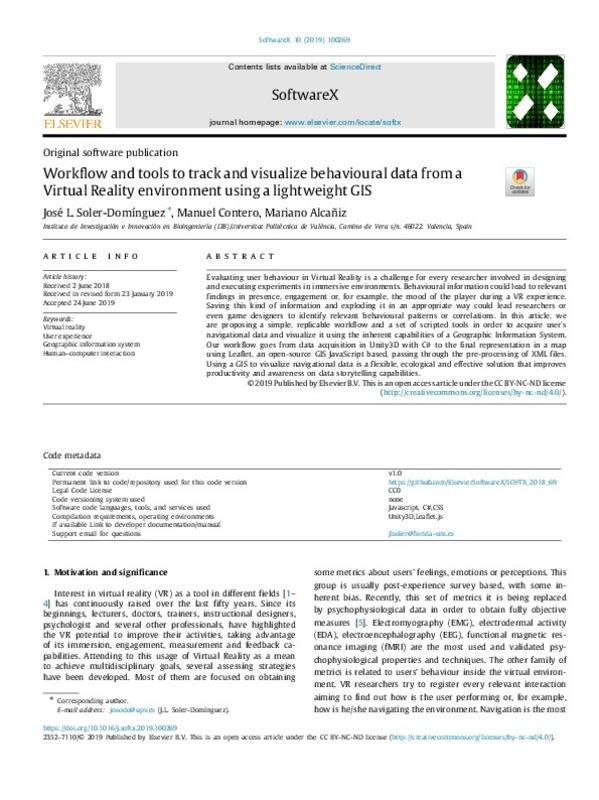Psotka, J. (1995). Immersive training systems: Virtual reality and education and training. Instructional Science, 23(5-6), 405-431. doi:10.1007/bf00896880
Riva, G. (2009). Virtual reality: an experiential tool for clinical psychology. British Journal of Guidance & Counselling, 37(3), 337-345. doi:10.1080/03069880902957056
McCloy, R., & Stone, R. (2001). Science, medicine, and the future: Virtual reality in surgery. BMJ, 323(7318), 912-915. doi:10.1136/bmj.323.7318.912
[+]
Psotka, J. (1995). Immersive training systems: Virtual reality and education and training. Instructional Science, 23(5-6), 405-431. doi:10.1007/bf00896880
Riva, G. (2009). Virtual reality: an experiential tool for clinical psychology. British Journal of Guidance & Counselling, 37(3), 337-345. doi:10.1080/03069880902957056
McCloy, R., & Stone, R. (2001). Science, medicine, and the future: Virtual reality in surgery. BMJ, 323(7318), 912-915. doi:10.1136/bmj.323.7318.912
Botella C, García Palacios A, Baños Rivera RM, Quero Castellano S, Bretón-López J. Virtual reality in the treatment of pain.
Kivikangas, J. M., Chanel, G., Cowley, B., Ekman, I., Salminen, M., Järvelä, S., & Ravaja, N. (2011). A review of the use of psychophysiological methods in game research. Journal of Gaming & Virtual Worlds, 3(3), 181-199. doi:10.1386/jgvw.3.3.181_1
Slater, M., Usoh, M., & Steed, A. (1995). Taking steps. ACM Transactions on Computer-Human Interaction, 2(3), 201-219. doi:10.1145/210079.210084
Rebenitsch, L., & Owen, C. (2016). Review on cybersickness in applications and visual displays. Virtual Reality, 20(2), 101-125. doi:10.1007/s10055-016-0285-9
Churchill, E. F., & Snowdon, D. (1998). Collaborative virtual environments: An introductory review of issues and systems. Virtual Reality, 3(1), 3-15. doi:10.1007/bf01409793
Huang, B., & Lin, H. (1999). GeoVR: a web-based tool for virtual reality presentation from 2D GIS data. Computers & Geosciences, 25(10), 1167-1175. doi:10.1016/s0098-3004(99)00073-4
Rhyne, T. M. (1997). Going virtual with geographic information and scientific visualization. Computers & Geosciences, 23(4), 489-491. doi:10.1016/s0098-3004(97)00017-4
VERBREE, E., MAREN, G. V., GERMS, R., JANSEN, F., & KRAAK, M.-J. (1999). Interaction in virtual world views-linking 3D GIS with VR. International Journal of Geographical Information Science, 13(4), 385-396. doi:10.1080/136588199241265
Faust, N. L. (1995). The virtual reality of GIS. Environment and Planning B: Planning and Design, 22(3), 257-268. doi:10.1068/b220257
Cushman, L. A., Stein, K., & Duffy, C. J. (2008). Detecting navigational deficits in cognitive aging and Alzheimer disease using virtual reality. Neurology, 71(12), 888-895. doi:10.1212/01.wnl.0000326262.67613.fe
Gillner, S., & Mallot, H. A. (1998). Navigation and Acquisition of Spatial Knowledge in a Virtual Maze. Journal of Cognitive Neuroscience, 10(4), 445-463. doi:10.1162/089892998562861
Sanchez-Vives, M. V., & Slater, M. (2005). From presence to consciousness through virtual reality. Nature Reviews Neuroscience, 6(4), 332-339. doi:10.1038/nrn1651
Nowak, K. L., & Biocca, F. (2003). The Effect of the Agency and Anthropomorphism on Users’ Sense of Telepresence, Copresence, and Social Presence in Virtual Environments. Presence: Teleoperators and Virtual Environments, 12(5), 481-494. doi:10.1162/105474603322761289
Slater, M., & Wilbur, S. (1997). A Framework for Immersive Virtual Environments (FIVE): Speculations on the Role of Presence in Virtual Environments. Presence: Teleoperators and Virtual Environments, 6(6), 603-616. doi:10.1162/pres.1997.6.6.603
Riva, G., Mantovani, F., Capideville, C. S., Preziosa, A., Morganti, F., Villani, D., … Alcañiz, M. (2007). Affective Interactions Using Virtual Reality: The Link between Presence and Emotions. CyberPsychology & Behavior, 10(1), 45-56. doi:10.1089/cpb.2006.9993
[-]









